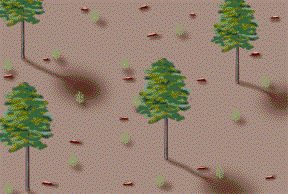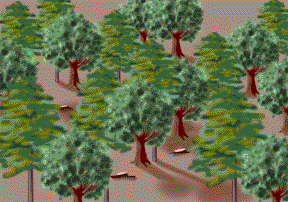
Timber Harvest Methods
Timber Harvesting Methods
In forest management, trees are harvested for a variety of reasons including improving the health of the forest; controlling the types of trees that grow on the site; attracting certain wildlife species; providing a source of income for the landowner; producing paper, lumber and numerous other forest products; and improving access to the area for hikers, hunters and other recreational users.
Just as there are many reasons for harvesting trees, there are many different harvesting methods. Each method has its benefits, drawbacks and conditions under which it is the most suitable way to harvest trees. No one harvesting method is ideal for all situations.
Clearcut
Clearcutting removes all the trees in a given area, much like a wildfire, hurricane or other natural disturbance would do. It is used most frequently in pine forests, which require full sunlight to grow, and in hardwood forests with yellow poplar, sweetgum, cherry, maple and other species that require full sunlight.
Clearcuts are an efficient way to convert unhealthy stands to healthy, productive forests because they allow forest managers to control the tree species that grow on the site through natural or artificial regeneration.
While a clearcut removes all canopy cover and is unattractive for a short period of time, it is an effective method for creating habitat for a variety of wildlife species. Animals that eat insects, such as turkeys and quails, and those that eat annual and perennial plants, such as bears and deer, thrive in recently clearcut areas. Many creatures also find shelter from weather and predators in the low growing grasses, bushes and briar thickets that follow this type of harvest. In addition, clearcutting is an important forest management tool because it can be used to create edges - areas where two habitat types or two ages of the same habitat meet. Because edges provide easy access to more than one habitat, they usually have more diverse wildlife communities than large blocks of a single habitat.

Shelterwood
In a shelterwood cut, mature trees are removed in two or three harvests over a period of 10 to 15 years. This method allows regeneration of medium to low shade-tolerant species because a "shelter" is left to protect them. Many hardwoods, such as oak, hickory and cherry, can produce and maintain seedlings or sprouts in light shade under a partially cut stand. However, the young trees will not grow and develop fully until the remaining overstory trees are removed.
One benefit to shelterwood harvests is that they provide cover and early successional food sources for wildlife. However, this method of harvest is not recommended for trees with shallow root systems because the remaining trees are more susceptible to wind damage after neighboring trees are removed. Another disadvantage to shelterwood cuts is that they require more roads to be built through the forest, and increase the risk of soil disturbance and damage to the remaining trees during harvesting.

Seed Tree
In a seed tree harvest, five or more scattered trees per acre are left in the harvested area to provide seeds for a new forest stand. These trees are selected based on their growth rate, form, seeding ability, wind resistance and future marketability.
Wildlife benefit from seed tree harvests in much the same way as they do from a clearcut harvest, except that they also reap the benefits of the seed trees themselves. If left on site indefinitely, seed trees eventually may become snags or downed logs, which are important habitat components for woodpeckers and many other species. Seed trees are also excellent food sources and nesting sites for hawks and other birds.
One disadvantage to seed tree harvests is that the remaining trees are at increased risk of damage from wind, lightening, insect attack and logging of nearby trees. This type harvest may also require the landowner to make future investments in thinning and competition control because of uncontrolled reseeding.

Group Selection
Group selection is essentially a small-scale clearcut where groups of trees in a given area are harvested over many years so that the entire stand has been cut within 40 to 50 years. This method is used primarily on bottomland hardwood stands to harvest high-quality, top dollar logs. The size of the group cut determines the tree species that are likely to return after the harvest. Openings that are less than one-fourth acre favor shade-tolerant species, and larger openings favor sun-loving species.
Group selection provides ideal pockets of young vegetation for grouse, deer and songbirds. But because it requires intensive management and frequent access to all areas of the property, it can be an expensive forest regeneration method.

Single-Tree Selection
Single-tree selection, the most intensive harvesting method, removes individual trees that are ready for harvest, of low value or in competition with other trees. With single-tree selection, the forest continuously produces timber and constantly has new seedlings emerging to take the place of harvested trees. Single-tree selection maintains a late succession forest that benefits many wildlife species such as squirrels and turkey.
Single-tree selection harvesting is best in small or confined areas for a variety of reasons. One is that this harvesting method requires more roads. In addition, surrounding trees can be damaged during harvests, and frequent use of logging equipment in a given area may compact the soil. Sun-loving trees, which are an important source of food for wildlife, do not regenerate well with single-tree selection, so forest managers must use mechanical or chemical controls to prevent shade-tolerant species from taking over the site.


